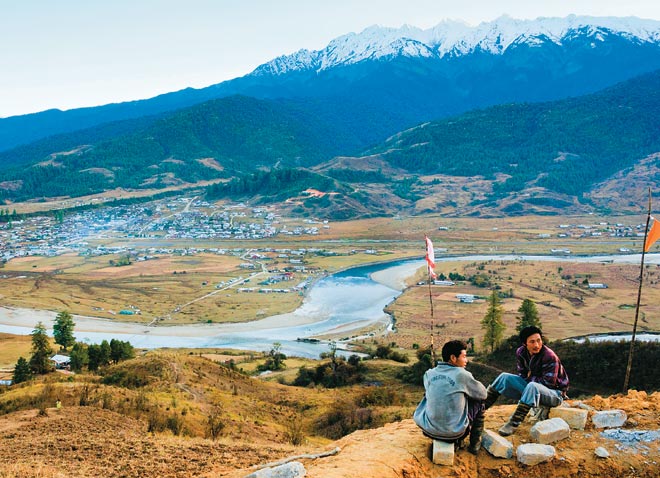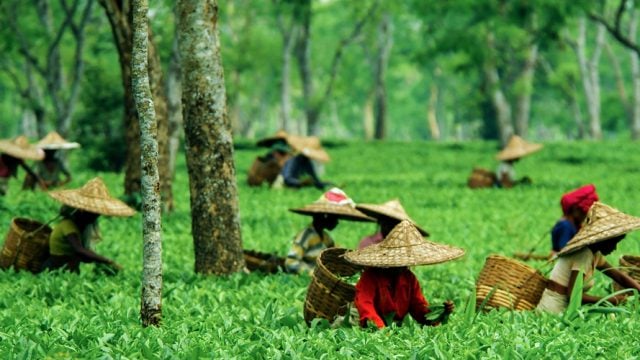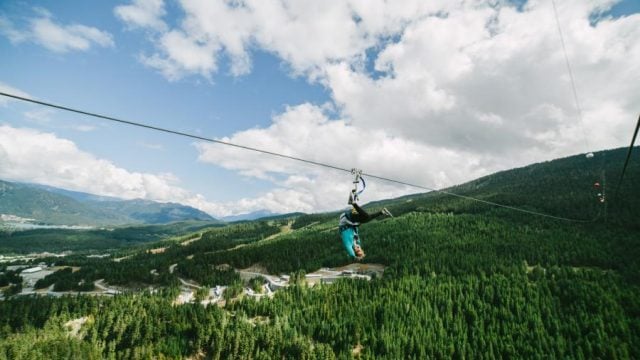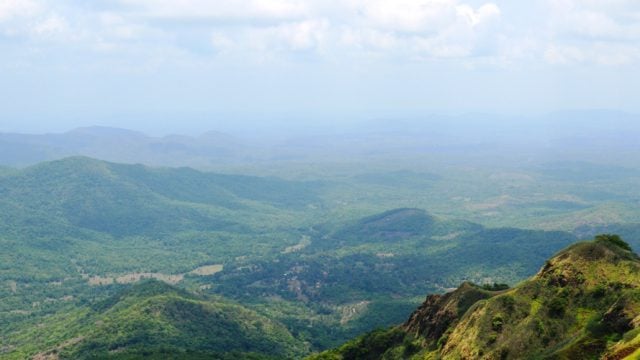Two flights, one ferry across the Brahmaputra, 36 hours on bumpy mountain roads, an hour’s wait for
Welcome to Arunachal Pradesh — where routine stuff is complicated, and serendipity commonplace. Things have a way of always working out here in the end. Especially after my third welcome drink (or was it the fourth?) of chang, a sweetish, warm millet brew, which a smiling Memba hostess effortlessly convinced me to down against my own better judgment.
Ah, Mechuka! It had been two long years ago that I had first visited this and other lovely places in Arunachal Pradesh as a research photographer, documenting the state’s incredibly skilled tribal weavers who skillfully use primitive ‘loin looms’ to turn thread directly into wearable clothes and all sorts of utility objects.
Among the diverse landscapes I was lucky enough to have experienced on that trip, it was Mechuka’s picture-postcard views of snow-capped peaks, vast meadows and evergreen pine forests that impressed me most visually. Here was a slice of Tibet, both in culture and landscape, surviving within India. I had promised myself I would return.

A Monpa singer was belting out old Bollywood hits on stage. The crowd loved it. This was a big event in Mechuka. Until recently, the bowl-shaped valley was known only for its airfield, and became accessible by road only a decade ago. Organised tourism is still far behind. China laid claim on Mechuka and the rest of Arunachal after annexing Tibet, so there’s an understandably strong Indian military presence here. Very few outsiders filter all the way up to Mechuka, simply because it is so difficult to reach.Delight after delight appeared on that brilliantly star-studded night — pork chilli and roasted mithun meat, a Northeastern delicacy, and of course, more chang. A mithun is a kind of semi-wild bovine, similar to buffaloes. Although they are privately owned like regular cattle, mithuns are allowed to roam and breed freely, eat wild vegetation and are never fully domesticated, leading to a ‘wilder’ tasting meat. Arunachali society traditionally measures a man’s social status by the amount of mithun meat he distributes for free to the entire village on festivals, in sharp contrast to modern cultures, which evaluate it on the basis of personal consumption.
There are so many things to learn from the Northeast, I thought. I was still glowing from the fact that I had made it this far a second time. Things were looking up. I was all set to go kayaking, rappelling, rock climbing, paragliding and whatever else came my way over the next couple of days. The mercury continued to plummet.
My hostess smiled.
“Some whiskey to keep you warm?”
Act II: Morning sunbeam striking left eyeball. The blanket is very cozy. The pinewood walls are neat and the windows overlook a spectacular mountain backdrop that is daily wallpaper here. I have no idea where I am or how I got here.
“You were really funny last night,” chuckled Anup, my new travel companion and fellow Arunachalophile. “Everyone in Mechuka knows you now.”
I had to take his word for it, and deemed it ideal that I couldn’t remember any of it.
As it turned out, we were at Ani Sona’s homestay. We never got to meet Ani but her mother-in-law, a sweet, elderly Memba lady, was our host. The largest, most important and inclusive room in such cultures is the kitchen. Chats, chai and cooking happen around a common fire, without socially excluding the people doing the cooking. The very nature of the open kitchen makes hotels seem cold and lifeless in comparison. It was around this fire that we would warm ourselves every morning, and get to know our host and her family over salty ghee-based tea; it’s surprisingly easy to get accustomed to the beverage.

The organised activities for the day didn’t go quite as planned. The para-motor-sailing rig had technical glitches and the pilot couldn’t do tandems, so he spent the day flying on his own, which wasn’t as much fun for the rest of us. The paragliding pilot also cited current issues, and eventually couldn’t keep up with the number of participants queuing up either. So we trekked up a hill for an hour but never made the flight.
Anup tried the river crossing, which wasn’t quite what he expected, since every participant got wet, defeating the point of using a cable to cross a river.
My philosophy at such times is simple: When in doubt, eat.
So we explored some of the food huts that had been put together especially for the festival — some of them represented cuisines of certain tribes, others were region-specific. The clincher for us was a cosy private tent with electric heating within one of the huts. The hardest part was deciding what to eat in so little time; everything looked promising.

Outside, an evening of dance and music was beginning, and visitors from different tribes were dressed in their beautiful, traditional costumes, which these days are rarely seen, except on festivals and special occasions. Thankfully, they didn’t realise that this wasn’t that kind of festival or even understand the adventure business. So they dressed and behaved just as they would have for any tribal festival. In hindsight, there was no way this could have ever gone wrong — put together a bunch of Arunachalis, and they’ll make merry, despite the plot.
This was already happening at our table as well; our heated tent had already begun to attract a diverse set of Arunachalis to our table.
“Remember, from last night?” one of them asked.
“Umm.. You see, I…”
“You were really high, ha ha!”
Following the requisite laughs at my expense, it was an enjoyable evening of drinks, meaty snacks and wide-ranging conversations and crosscultural exchange. Arunachalis are an open, liberal and uncomplicated people in general. Almost any topic is approachable in social gatherings, and they always go out of their way to make visitors feel welcome and included in matters close to their hearts.
We gave adventure sports another shot on the following day. We rappelled down a rock cliff and it was a lot of fun, but again, it ended there. We could see where this was leading. Clearly, the festival was just a pretext to come to Mechuka and slip in socially through the backdoor into a fascinating culture that’s visibly in transition. How else would we have found all the villagers in the same place at the same time? It was worth every hour of travel. I would have it no other way.
The food just kept getting better and better — this time, we tried a different hut and ordered pah, sticky millet cakes, Memba-style, served with corn soup and crispy-dry, spicy and fat-laden country pork strips with a red chilli chutney and salad. They took over an hour to prepare but it was the best pork I had ever had in my life. It was so good that we ordered three more plates. The women running the hut, moved by our interest in their cuisine, joined us at the table for a fresh round of chat. That night we eventually landed up on a freezing midnight spin on an open-top jeep and eventually found ourselves around another kitchen fire. Such were the nights — long, arbitrary, social, surreal.
As much fun as this was, I knew I would have to get a car and move about to see more of Mechuka. This, however, was easier said than done — my first driver had vanished along with the car. No one had heard from him since. I spent a whole day just waiting for him, munching on momos, which, in hindsight, wasn’t such a bad deal.
A great deal of effort and considerable government assistance finally got me a second vehicle and driver, so I managed a short morning excursion through the countryside to to the Mahayana Buddhist ‘Old Gompa’ of Samten Yongcha. This 15th-century institution, perched on a hill overlooking the Yarbak Tsu river valley and peaks like Tanzen La, is even older than the 17th-century monastery at Tawang, but not as well known.

I made the hour’s uphill trek with my guide Gebu. It’s always a pleasure to enter Buddhist temples. Tibetan Buddhism, a cross between ‘pure’ Buddhism and the indigenous Bon religion, is vividly rich with spirits, demons and mountain gods, its mythology set around Tantric, reincarnation and enlightenment themes. The Old Gompa’s idols, paintings and dance masks are especially impressive. Some of its relics and scriptures are twice as old as the gompa itself..
Following this small excursion, my new driver also abandoned me, citing fatigue. Off he went in a cloud of dust. It wasn’t easy to get used to this.
When in doubt, eat.
Momos again?’ I wondered, as I narrated my lot to a government employee whom I had met at the festival.
“Why don’t you come and have lunch at today’s picnic?” he suggested. I wasn’t going to hazard scoring another car and a picnic with the who’s who of Mechuka promised to be an event in itself. Resistance was futile.
We drove along the banks of the Siom river, parked by a stream and climbed up to a grassy cliff overlooking the valley. This picnic was quite the happy picture — I recognised some faces and saw more tribespeople in traditional attire. They were all extremely friendly and welcoming, and insisted that I get my glass along with an appetiser-snack of dry, cauldron-roasted chicken bits, cut small and cooked in turmeric, chilli and local garlic, with the skin and bones on. A bit undercooked, but in a way that I prefer. Simple, yet delicious.
I received a fair share of attention and hospitality as a visitor, this time from Ramo tribesmen I had just met. They gave me some truly awesome travel suggestions and invited me to stay at their homes, go on long excursions through the forest with them, and explore magical places, which they described in colourful detail — weeklong treks over snowy passes, unknown, crystal-studded high-altitude caves, the Podhi Bharvi festival at Manigang…
One sweet couple from Tato even decided to gift me a beautiful, handmade, woollen cloak just fifteen minutes after meeting me. “It’s our gift to you,” they said. “You’ve come such a long way to visit our land. We would like you to have this.” Having researched these very textiles before, I knew what the garment was worth — weeks of dedicated, backbreaking weaving by hand, with love, sweat and patience. It was touching beyond words. I felt immensely grateful to my driver for ditching me.
The food smelt great, as it cooked in huge cauldrons over wood fire. There was rice, a boiled chicken with vegetables and laipatta, a crunchy, local leafy vegetable that’s as high on taste as it is on nutrition. The food was a paradox — much of it is boiled without oil or spices but fiery red chilli may have been liberally used in dishes you were told haven’t been ‘spiced,’ since they don’t consider chilli a spice.
Our shadows grew longer as the sun had begun to set over the really high mountain across the river. The friend who led me here had left. So far during my trip here, I had been mingling mostly with the Membas, who are of Tibetan stock. This was my first intimate interaction with the Ramos who, along with the Bokar and Libo tribes, make up much of the Mechuka area’s population. The once-nomadic Ramos are also believed to have migrated from Tibet long ago, but unlike the Buddhist Membas, practice Donyi-Polo, which literally means (worship of the) ‘sun and moon’. Like other animists, Ramos worship nature and believe in the inter-connectedness of all beings.

The picnic officially ended after a few rounds of target shooting, but the Ramo boys and I took our picnic with us to a wooden cable bridge over the riverside. A chopper flew past and disappeared behind the hills. This was an event. Army jawans occasionally ran past us in a long file across the bridge on their night drill.
On my last evening out in Mechuka town my new friends regaled me with stories from the forest — near-mythical creatures that only hunters had ever seen, a grass that acts like a truth serum when eaten, a bush in the Manigang forests whose pollen is so potent that just breathing the wind crossing it is enough to induce the most profound sense of bliss, forests so beautiful they could make a grown man cry with joy… Under the brilliant constellations, the snow was glowing on blunt peaks, rim-lit by the rising moon. There was a nip in the air and the darkening sky was overwhelmingly beautiful. My heart went out to Mechuka. On a night like that, you just have to believe.
The information
Getting there
Mechuka (at 6,000ft, sometimes also spelt as Mechukha and Menchukha) is a picturesque valley overlooking the high Himalaya 29km from the Indo-Tibetan border in Arunachal Pradesh’s West Siang district. Mechuka is now being pushed by the tourism authorities as the next big destination in the Northeast. Go there before it becomes anything of the sort!
Via Dibrugarh airport or railway station: hire a car or take a shared taxi from Dibrugarh to Along (432km). This is an all-day journey and will involve loading the vehicle on a ferry across the Brahmaputra. After an overnight halt at Along, hire a car/take a shared taxi to Mechuka (180km). Via Guwahati airport or railway station: take the Pawan Hans chopper to Itanagar (Naharlagun). Then hire a car/take a shared taxi from Itanagar to Along (292km), and thence to Mechuka.The railway station in Chapari , Assam, is another option. It is 134km from Mechuka but less connected.
Where to stay
Homestays are a far better option than hotels here. The Government’s new RCC tourist facilities are also best avoided. Try Gayboo’s Traditional Lodge (9402996667), which also organises excursions. Almost Heritage (9436672849) is also worth checking out.
Walk-in reservations can also be negotiated at Ani Sona’s Guest house or DK Chukla’s homestay. Everyone knows everyone else here, so asking around easily leads to spontaneous accommodation solutions.
What to see & do
“Adventure at Mechukha”, the Mechukha Adventure Festival, was a three-day adventure gala organised from November 7-9 by the Ministry of Tourism, Government of India, and the Department of Tourism, Government of Arunachal Pradesh. In addition, there are cultural events, food stalls and shopping. You can look them up on Facebook under ‘Adventure at Mechukha’. Activities included trap shooting, rappelling, river crossing, paragliding, mountain biking and aero-modelling.
The Government Craft Centre is good for purchasing handicrafts like Tibetan-style Thaan carpets. Visit the 15th-century Buddhist gompa of Samten Yongcha, or the ‘old gompa,’ as it is popularly known. Day hikes to Dorjiling and other nearby villages are rewarding. A 2-3-day hike through pine forests and river banks leads to the Pasang Sonam Tso.
More information is available from the office of the Deputy Commissioner, Along (3783-222221), the office of the Additional Deputy Commissioner, Mechukha (9436421544), the Circle Officer at Mechukha (9436258555), and arunachaltourism.org.
Arunachal Pradesh
Mechuka Valley
Northeast India





